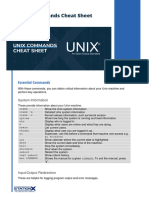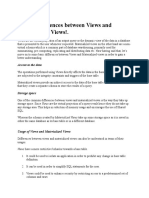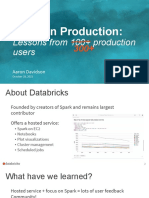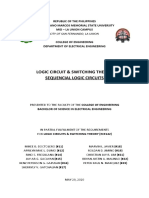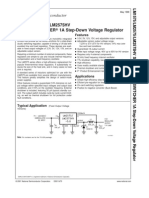Data
Engineering 101
Amazon Redshift
Shwetank Singh
GritSetGrow - GSGLearn.com
� Data Engineering 101: Redshift
Cluster
An Amazon Redshift cluster is a set of nodes
that work together to store and process data.
Each cluster contains one or more databases.
Creating a cluster:
aws redshift create-cluster --cluster-identifier my-
cluster --node-type dc2.large --master-username
admin --master-user-password Password123 --
number-of-nodes 2
Shwetank Singh
GritSetGrow - GSGLearn.com
�Data Engineering 101: Redshift
Node Types
Amazon Redshift offers different node types
optimized for different workloads, including
Dense Compute (DC) and Dense Storage (DS).
DC2 instances are ideal for performance-intensive
workloads, while DS2 instances are optimized for
large storage needs.
Shwetank Singh
GritSetGrow - GSGLearn.com
� Data Engineering 101: Redshift
Leader Node
The leader node manages communications
with client applications and all nodes in the
cluster, receiving queries and distributing them
to the compute nodes.
The leader node coordinates query processing and
aggregation of results before sending them to the
client.
Shwetank Singh
GritSetGrow - GSGLearn.com
�Data Engineering 101: Redshift
Compute Node
Compute nodes execute the queries and store
data. They send intermediate results back to
the leader node for aggregation.
Compute nodes store table data and perform query
processing.
Shwetank Singh
GritSetGrow - GSGLearn.com
� Data Engineering 101: Redshift
Columnar Storage
Amazon Redshift stores data in a columnar
format, which allows for more efficient data
compression and query performance,
especially for read-intensive operations.
Columnar storage reduces I/O and speeds up query
performance, as only the columns needed by a
query are scanned.
Shwetank Singh
GritSetGrow - GSGLearn.com
� Data Engineering 101: Redshift
Sort Keys
Sort keys determine the order in which data is
physically stored in Amazon Redshift tables,
optimizing query performance by reducing the
amount of data scanned.
Define a sort key: CREATE TABLE sales (id INT, date
DATE, amount FLOAT) SORTKEY (date);
Shwetank Singh
GritSetGrow - GSGLearn.com
� Data Engineering 101: Redshift
Distribution Keys
Distribution keys determine how data is
distributed across the compute nodes. Proper
selection of distribution keys can minimize
data movement and optimize performance.
Define a distribution key: CREATE TABLE sales (id INT,
date DATE, amount FLOAT) DISTKEY (id);
Shwetank Singh
GritSetGrow - GSGLearn.com
�Data Engineering 101: Redshift
Compression
Amazon Redshift automatically compresses
data to save storage and improve query
performance. Compression types include LZO,
Zstandard, and Delta.
COPY sales FROM 's3://bucket-name/sales_data.csv'
COMPUPDATE ON;
Shwetank Singh
GritSetGrow - GSGLearn.com
�Data Engineering 101: Redshift
Vacuum
The VACUUM command reclaims space and
sorts tables to optimize performance after
large DELETE or UPDATE operations.
VACUUM FULL sales;
Shwetank Singh
GritSetGrow - GSGLearn.com
�Data Engineering 101: Redshift
Analyze
The ANALYZE command updates table statistics
to help the query planner create optimal
execution plans.
ANALYZE sales;
Shwetank Singh
GritSetGrow - GSGLearn.com
� Data Engineering 101: Redshift
Materialized Views
Materialized views store the results of a query
physically, allowing for faster retrieval in
subsequent queries.
CREATE MATERIALIZED VIEW mv_sales AS SELECT
date, SUM(amount) FROM sales GROUP BY date;
Shwetank Singh
GritSetGrow - GSGLearn.com
� Data Engineering 101: Redshift
Snapshots
Redshift snapshots capture the current state of
your data, which can be used for backup or
recovery. Snapshots can be manual or
automatic.
CREATE SNAPSHOT my_snapshot FROM my-cluster;
Shwetank Singh
GritSetGrow - GSGLearn.com
�Data Engineering 101: Redshift
Backup and Restore
Amazon Redshift automatically takes
incremental snapshots and allows users to
manually create and restore from these
snapshots.
RESTORE FROM SNAPSHOT my_snapshot;
Shwetank Singh
GritSetGrow - GSGLearn.com
�Data Engineering 101: Redshift
Concurrency Scaling
Concurrency scaling allows Redshift to
automatically add additional capacity to
handle large numbers of queries concurrently.
ENABLE CONCURRENCY SCALING in the cluster
configuration to manage high query loads.
Shwetank Singh
GritSetGrow - GSGLearn.com
� Data Engineering 101: Redshift
Elastic Resize
Allows for quickly resizing the cluster, adding
or removing nodes to adjust to workload
demands.
aws redshift modify-cluster --cluster-identifier my-
cluster --number-of-nodes 4
Shwetank Singh
GritSetGrow - GSGLearn.com
� Data Engineering 101: Redshift
Redshift Spectrum
Redshift Spectrum enables querying data
directly from S3 without loading it into Redshift
tables.
SELECT * FROM spectrum_table; with spectrum_table
defined as an external table pointing to S3 data.
Shwetank Singh
GritSetGrow - GSGLearn.com
�Data Engineering 101: Redshift
External Tables
External tables allow Amazon Redshift to query
data stored outside of Redshift, typically in
Amazon S3, using Redshift Spectrum.
CREATE EXTERNAL TABLE spectrum.sales (...) STORED
AS PARQUET LOCATION 's3://bucket-
name/sales_data/';
Shwetank Singh
GritSetGrow - GSGLearn.com
�Data Engineering 101: Redshift
WLM (Workload
Management)
WLM allows you to define queues that allocate
resources based on query priority, enabling
better management of multiple workloads.
ALTER WLM CONFIGURATION ADD QUEUE myqueue
WITH MEMORY_PERCENTAGE=25;
Shwetank Singh
GritSetGrow - GSGLearn.com
�Data Engineering 101: Redshift
RA3 Instances
RA3 instances decouple compute and storage,
allowing users to scale compute and storage
independently.
CREATE CLUSTER with ra3.16xlarge instance types for
compute/storage decoupling.
Shwetank Singh
GritSetGrow - GSGLearn.com
�Data Engineering 101: Redshift
Query Monitoring Rules
(QMR)
QMR helps in monitoring and managing
runaway queries by setting rules that define
when a query should be canceled or alerted.
CREATE QUERY MONITORING RULE
abort_long_running_query AS rule_action = log;
Shwetank Singh
GritSetGrow - GSGLearn.com
� Data Engineering 101: Redshift
Automatic Table
Optimization
Redshift automatically chooses the best sort
and distribution keys for tables based on usage
patterns, optimizing query performance.
Automatic optimization suggestions can be viewed
and applied by reviewing the recommendations in
the AWS Management Console.
Shwetank Singh
GritSetGrow - GSGLearn.com
�Data Engineering 101: Redshift
Stored Procedures
Stored procedures allow you to write
procedural code that runs on the Redshift
server, helping automate tasks such as data
transformation.
CREATE PROCEDURE sp_myproc() BEGIN ... END;
Shwetank Singh
GritSetGrow - GSGLearn.com
� Data Engineering 101: Redshift
UDF (User Defined Functions)
UDFs let you write custom functions in SQL or
Python to perform complex calculations or
data manipulations within queries.
CREATE FUNCTION myfunction(val INT) RETURNS INT
IMMUTABLE AS $$ BEGIN RETURN val * 2; END; $$
LANGUAGE plpgsql;
Shwetank Singh
GritSetGrow - GSGLearn.com
� Data Engineering 101: Redshift
Data Sharing
Amazon Redshift data sharing allows secure
and efficient sharing of live data across
different Redshift clusters without needing to
copy data.
ALTER DATASHARE myshare ADD SCHEMA public; to
share schema across clusters.
Shwetank Singh
GritSetGrow - GSGLearn.com
� Data Engineering 101: Redshift
Enhanced VPC Routing
Enhanced VPC Routing forces all COPY and
UNLOAD traffic between your cluster and data
repositories in S3 to go through your Amazon
VPC.
ENABLE ENHANCED VPC ROUTING in the cluster
configuration to route traffic securely through VPC.
Shwetank Singh
GritSetGrow - GSGLearn.com
� Data Engineering 101: Redshift
Column-Level Encryption
Redshift supports column-level encryption,
allowing you to encrypt specific columns of
your data at rest using AWS KMS keys.
CREATE TABLE sensitive_data (ssn CHAR(11) ENCODE
BYTEDICT ENCRYPTED);
Shwetank Singh
GritSetGrow - GSGLearn.com
�Data Engineering 101: Redshift
Data API
Redshift Data API provides a way to run SQL
commands against Redshift clusters without
needing to manage connections, useful for
serverless applications.
aws redshift-data execute-statement --cluster-
identifier my-cluster --database mydb --sql "SELECT
* FROM sales;"
Shwetank Singh
GritSetGrow - GSGLearn.com
�Data Engineering 101: Redshift
UNLOAD Command
The UNLOAD command exports result sets
from Redshift tables to Amazon S3 in various
formats, such as text or Parquet.
UNLOAD ('SELECT * FROM sales') TO 's3://bucket-
name/unload/' IAM_ROLE
'arn:aws:iam::123456789012:role/MyRedshiftRole'
FORMAT AS PARQUET;
Shwetank Singh
GritSetGrow - GSGLearn.com
�Data Engineering 101: Redshift
COPY Command
The COPY command loads data from Amazon
S3, DynamoDB, or other sources into Redshift
tables. It supports various data formats and
parallelism.
COPY sales FROM 's3://bucket-name/sales_data.csv'
IAM_ROLE
'arn:aws:iam::123456789012:role/MyRedshiftRole'
CSV;
Shwetank Singh
GritSetGrow - GSGLearn.com
�Data Engineering 101: Redshift
Concurrency Scaling
Enables Amazon Redshift to automatically add
additional capacity to handle large numbers of
queries concurrently.
ALTER SYSTEM SET concurrency_scaling=ON;
Shwetank Singh
GritSetGrow - GSGLearn.com
�Data Engineering 101: Redshift
Redshift ML
Allows users to create machine learning
models directly within Redshift using SQL
queries, powered by Amazon SageMaker.
CREATE MODEL my_model FROM (SELECT * FROM
sales) TARGET amount;
Shwetank Singh
GritSetGrow - GSGLearn.com
� Data Engineering 101: Redshift
Partitioning in Spectrum
Partitioning in Spectrum helps optimize
queries on external tables by reducing the
amount of data scanned by splitting it into
partitions.
ALTER TABLE spectrum.sales ADD PARTITION
(year=2023, month=1) LOCATION 's3://bucket-
name/sales/2023/01/';
Shwetank Singh
GritSetGrow - GSGLearn.com
�Data Engineering 101: Redshift
AWS Glue Data Catalog
AWS Glue Data Catalog is a fully managed
service that lets you store and retrieve
metadata about your data, which can be
queried by Redshift Spectrum.
CREATE EXTERNAL SCHEMA spectrum FROM DATA
CATALOG DATABASE 'mycatalogdb' IAM_ROLE
'arn:aws:iam::123456789012:role/MyRedshiftRole';
Shwetank Singh
GritSetGrow - GSGLearn.com
�Data Engineering 101: Redshift
Concurrency Limits
Redshift manages concurrency by allocating
resources to different queries based on the
defined WLM settings and query priority.
Monitoring concurrency: SELECT * FROM
stv_wlm_query_state;
Shwetank Singh
GritSetGrow - GSGLearn.com
�Data Engineering 101: Redshift
Amazon S3 Integration
Redshift integrates with Amazon S3 for data
ingestion and backup, enabling seamless data
transfer between Redshift and S3 for large-
scale data processing.
Data ingestion: COPY mytable FROM 's3://bucket-
name/data.csv' IAM_ROLE
'arn:aws:iam::123456789012:role/MyRedshiftRole';
Shwetank Singh
GritSetGrow - GSGLearn.com
� Data Engineering 101: Redshift
Security Groups
Redshift uses Amazon VPC security groups to
control inbound and outbound traffic to your
Redshift clusters, providing network-level
security.
aws redshift modify-cluster --cluster-identifier my-
cluster --vpc-security-group-ids sg-12345678
Shwetank Singh
GritSetGrow - GSGLearn.com
� Data Engineering 101: Redshift
Audit Logging
Audit logging in Redshift allows you to track
database events and query activity for security
and compliance purposes by saving logs to
Amazon S3.
ENABLE AUDIT LOGGING in cluster configuration to
store logs in S3.
Shwetank Singh
GritSetGrow - GSGLearn.com
� Data Engineering 101: Redshift
Automated Snapshots
Redshift automatically creates snapshots of
your data to protect against data loss, which
can be configured for specific intervals and
retention periods.
Configure snapshots: aws redshift modify-cluster-
snapshot-schedule --cluster-identifier my-cluster --
snapshot-schedule my-schedule
Shwetank Singh
GritSetGrow - GSGLearn.com
� Data Engineering 101: Redshift
Event Notifications
Amazon Redshift can send notifications for
specific events such as cluster creation,
deletion, or failure, using SNS (Simple
Notification Service).
aws redshift create-event-subscription --
subscription-name my-subscription --sns-topic-arn
arn:aws:sns:region:123456789012:my-topic --
source-type cluster --source-ids my-cluster --event-
categories availability, security
Shwetank Singh
GritSetGrow - GSGLearn.com
�Data Engineering 101: Redshift
Cluster Parameter Groups
Cluster parameter groups allow you to
configure database engine settings for your
Amazon Redshift cluster, which can be applied
at runtime or during a reboot.
Modify parameter group: aws redshift modify-
cluster-parameter-group --parameter-group-name
my-param-group --parameters
"parameterName=value"
Shwetank Singh
GritSetGrow - GSGLearn.com
�Data Engineering 101: Redshift
Reserved Instances
Reserved instances allow you to save on long-
term costs by committing to a one- or three-
year term for Redshift clusters, offering
significant discounts over on-demand pricing.
Purchase Reserved Instance: aws redshift purchase-
reserved-node-offering --reserved-node-offering-id
offering-id --node-count 1`
Shwetank Singh
GritSetGrow - GSGLearn.com
� Data Engineering 101: Redshift
Elastic IP Address
An Elastic IP address (EIP) is a static IPv4
address that you can associate with your
Redshift cluster, allowing for consistent access
even after a cluster restart.
Allocate and associate EIP: aws ec2 associate-
address --instance-id my-instance-id --allocation-id
eipalloc-12345678`
Shwetank Singh
GritSetGrow - GSGLearn.com
� Data Engineering 101: Redshift
Cluster Resizing
Cluster resizing allows you to add or remove
nodes in your Redshift cluster to adjust for
changes in workload, supporting both classic
and elastic resize options.
aws redshift modify-cluster --cluster-identifier my-
cluster --number-of-nodes 4 for elastic resize.
Shwetank Singh
GritSetGrow - GSGLearn.com
� Data Engineering 101: Redshift
Data Transfer Costs
Data transfer costs in Redshift refer to the fees
incurred when moving data between Redshift
and other AWS services, such as S3, over the
internet or across regions.
Monitoring data transfer: Check the AWS Cost
Explorer for data transfer costs associated with your
Redshift usage.
Shwetank Singh
GritSetGrow - GSGLearn.com
�Data Engineering 101: Redshift
Enhanced Logging
Enhanced logging in Redshift captures detailed
information about each query, including
execution time, plan, and resource
consumption, which can be analyzed for
performance tuning.
Enable enhanced logging by setting up logging
parameters in your Redshift cluster settings.
Shwetank Singh
GritSetGrow - GSGLearn.com
� Data Engineering 101: Redshift
Encryption at Rest
Redshift supports encryption of data at rest
using AWS Key Management Service (KMS) or
customer-managed keys, ensuring that data is
protected even when stored.
Enable encryption: aws redshift create-cluster --
cluster-identifier my-cluster --encrypted --kms-key-
id my-kms-key-id
Shwetank Singh
GritSetGrow - GSGLearn.com
�Data Engineering 101: Redshift
Query Caching
Redshift caches the results of queries to
improve performance for repeated queries by
storing the results and serving them directly
when the same query is executed again.
Query results are cached by default. Use the EXPLAIN
command to see if a cached result is being used.
Shwetank Singh
GritSetGrow - GSGLearn.com
� Data Engineering 101: Redshift
Manual Snapshots
Manual snapshots are user-initiated backups
of your Redshift cluster that can be retained for
an indefinite period, allowing you to restore
the cluster to a specific point in time.
Create a manual snapshot: aws redshift create-
cluster-snapshot --snapshot-identifier my-snapshot
--cluster-identifier my-cluster
Shwetank Singh
GritSetGrow - GSGLearn.com
�Data Engineering 101: Redshift
Database User Management
Redshift allows you to create, manage, and
delete database users and groups, controlling
access to data and operations within the
cluster.
CREATE USER myuser WITH PASSWORD
'mypassword'; GRANT SELECT ON mytable TO
myuser;
Shwetank Singh
GritSetGrow - GSGLearn.com
� Data Engineering 101: Redshift
IAM Role Integration
Redshift integrates with AWS IAM roles to allow
fine-grained access control to AWS services,
enabling secure data access and operations
within Redshift.
aws redshift create-cluster --cluster-identifier my-
cluster --iam-roles
arn:aws:iam::123456789012:role/MyRedshiftRole
Shwetank Singh
GritSetGrow - GSGLearn.com
� Data Engineering 101: Redshift
Federated Authentication
Federated authentication allows you to
authenticate Redshift users with credentials
from other identity providers, such as
Microsoft AD or AWS Cognito.
Set up federated authentication with SAML 2.0
integration for your Redshift cluster.
Shwetank Singh
GritSetGrow - GSGLearn.com
�Data Engineering 101: Redshift
Automatic WLM Tuning
Redshift can automatically tune your Workload
Management (WLM) settings to optimize query
performance based on historical query
patterns and workload characteristics.
Enable automatic WLM tuning in the Redshift
console or using the AWS CLI.
Shwetank Singh
GritSetGrow - GSGLearn.com
� Data Engineering 101: Redshift
Cluster Maintenance
Redshift performs regular maintenance on
your clusters during predefined maintenance
windows to apply updates, patches, and fixes.
Configure maintenance window: aws redshift
modify-cluster --cluster-identifier my-cluster --
preferred-maintenance-window sun:05:00-
sun:05:30
Shwetank Singh
GritSetGrow - GSGLearn.com
� Data Engineering 101: Redshift
Database Auditing
Redshift supports auditing database activities,
allowing you to track changes to database
configurations, access controls, and query
execution for compliance and security.
Enable and configure database auditing in your
Redshift cluster settings.
Shwetank Singh
GritSetGrow - GSGLearn.com
�Data Engineering 101: Redshift
Cross-Region Snapshots
Cross-region snapshots enable you to copy
your Redshift snapshots to another AWS
region, providing disaster recovery and backup
capabilities across regions.
aws redshift copy-cluster-snapshot --source-
snapshot-identifier my-snapshot --target-snapshot-
identifier my-snapshot-copy --target-region us-west-
2
Shwetank Singh
GritSetGrow - GSGLearn.com
� Data Engineering 101: Redshift
Performance Insights
Performance Insights provide a dashboard to
visualize and monitor the performance of your
Redshift cluster, helping identify and resolve
performance bottlenecks.
Enable Performance Insights in the Redshift console
to start monitoring your cluster.
Shwetank Singh
GritSetGrow - GSGLearn.com
� Data Engineering 101: Redshift
Cluster Security
Configuration
Redshift clusters can be configured with
security features such as SSL encryption, VPC
security groups, and cluster parameter groups
to ensure secure access and operation.
Configure SSL encryption: aws redshift modify-
cluster --cluster-identifier my-cluster --cluster-
security-groups sg-12345678 --parameter-group-
name my-parameter-group
Shwetank Singh
GritSetGrow - GSGLearn.com
�Data Engineering 101: Redshift
IAM Database Authentication
IAM Database Authentication allows you to use
IAM credentials to authenticate to your
Redshift database, simplifying the
management of database access.
Enable IAM Database Authentication: aws redshift
modify-cluster --cluster-identifier my-cluster --
enable-iam-database-authentication
Shwetank Singh
GritSetGrow - GSGLearn.com
� Data Engineering 101: Redshift
Data Transfer Accelerator
Redshift's data transfer accelerator speeds up
data transfers between your S3 buckets and
Redshift, reducing the time required for large-
scale data imports and exports.
Enable data transfer accelerator in your Redshift
configuration settings.
Shwetank Singh
GritSetGrow - GSGLearn.com
� Data Engineering 101: Redshift
Query Optimizer
The Redshift query optimizer analyzes and
optimizes SQL queries for performance,
ensuring efficient use of resources and quick
query execution times.
Use the EXPLAIN command to see the query
execution plan and optimization strategies applied
by the optimizer.
Shwetank Singh
GritSetGrow - GSGLearn.com
� Data Engineering 101: Redshift
Instance Hour Billing
Redshift billing is based on instance hours,
which are the number of hours your cluster's
nodes are running. Costs depend on the
instance type and region.
Monitor instance hour usage: Use the AWS Cost
Explorer to view instance hour billing details for your
Redshift cluster.
Shwetank Singh
GritSetGrow - GSGLearn.com
� Data Engineering 101: Redshift
Data Lake Integration
Redshift integrates with AWS Data Lake
services, allowing you to query and analyze
data stored in the data lake without moving it
into Redshift.
Set up a Data Lake integration with Redshift
Spectrum to query S3 data without loading it into
the cluster.
Shwetank Singh
GritSetGrow - GSGLearn.com
� Data Engineering 101: Redshift
Database Audit Logging
Audit logging in Redshift captures logs of
database activities, including connections,
disconnections, and SQL queries, for security
and compliance monitoring.
Configure audit logging: aws redshift enable-audit-
logging --cluster-identifier my-cluster --bucket-name
my-log-bucket
Shwetank Singh
GritSetGrow - GSGLearn.com
�Data Engineering 101: Redshift
Lambda Integration
Amazon Redshift can invoke AWS Lambda
functions from within SQL queries, allowing
you to perform complex processing or
integrate with other AWS services.
Use Lambda UDFs: C̀REATE FUNCTION
mylambda_udf() RETURNS float AS
'arn:aws:lambda:
Shwetank Singh
GritSetGrow - GSGLearn.com


















